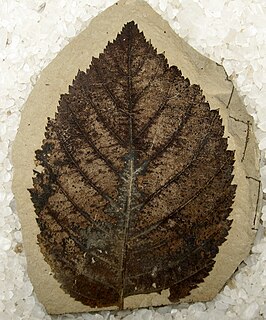 W
WPaleobotany, which is also spelled as palaeobotany, is the branch of botany dealing with the recovery and identification of plant remains from geological contexts, and their use for the biological reconstruction of past environments (paleogeography), and the evolutionary history of plants, with a bearing upon the evolution of life in general. A synonym is paleophytology. It is a component of paleontology and paleobiology. The prefix palaeo- means "ancient, old", and is derived from the Greek adjective παλαιός, palaios. Paleobotany includes the study of terrestrial plant fossils, as well as the study of prehistoric marine photoautotrophs, such as photosynthetic algae, seaweeds or kelp. A closely related field is palynology, which is the study of fossilized and extant spores and pollen.
 W
WPaleoecology is the study of interactions between organisms and/or interactions between organisms and their environments across geologic timescales. As a discipline, paleoecology interacts with, depends on and informs a variety of fields including paleontology, ecology, climatology and biology.
 W
WA trace fossil, also ichnofossil, is a fossil record of biological activity but not the preserved remains of the plant or animal itself. Trace fossils contrast with body fossils, which are the fossilized remains of parts of organisms' bodies, usually altered by later chemical activity or mineralization. Ichnology is the study of such trace fossils and is the work of ichnologists.
 W
WPaleolimnology is a scientific subdiscipline closely related to both limnology and paleoecology. Palaeolimnological studies are concerned with reconstructing the paleoenvironments of inland waters – and especially changes associated with such events as climatic change, human impacts, and internal ontogenic processes.
 W
WMicropaleontology is the branch of paleontology (palaeontology) that studies microfossils, or fossils that require the use of a microscope to see the organism, its morphology and its characteristic details.
 W
WMolecular paleontology refers to the recovery and analysis of DNA, proteins, carbohydrates, or lipids, and their diagenetic products from ancient human, animal, and plant remains. The field of molecular paleontology has yielded important insights into evolutionary events, species' diasporas, the discovery and characterization of extinct species. By applying molecular analytical techniques to DNA in fossils, one can quantify the level of relatedness between any two organisms for which DNA has been recovered.
 W
WNeoichnology is the science of footprints and traces of extant animals. Thus, it is a counterpart to paleoichnology, which investigates tracks and traces of fossil animals. Neoichnological methods are used in order to study the locomotion and the resulting tracks of both invertebrates and vertebrates. Often these methods are applied in the field of palaeobiology to gain a deeper understanding of fossilized footprints.
 W
WPaleobiology is a growing and comparatively new discipline which combines the methods and findings of the life science biology with the methods and findings of the earth science paleontology. It is occasionally referred to as "geobiology".
 W
WPaleopedology is the discipline that studies soils of past geological eras, from quite recent (Quaternary) to the earliest periods of the Earth's history. Paleopedology can be seen either as a branch of soil science (pedology) or of paleontology, since the methods it uses are in many ways a well-defined combination of the two disciplines.
 W
WPaleophycology is the subdiscipline of paleobotany that deals with the study and identification of fossil algae and their evolutionary relationships and ecology.
 W
WPalaeozoology, also spelled as Paleozoology, is the branch of paleontology, paleobiology, or zoology dealing with the recovery and identification of multicellular animal remains from geological contexts, and the use of these fossils in the reconstruction of prehistoric environments and ancient ecosystems.
 W
WPalynology is literally the "study of dust" or of "particles that are strewn". A classic palynologist analyses particulate samples collected from the air, from water, or from deposits including sediments of any age. The condition and identification of those particles, organic and inorganic, give the palynologist clues to the life, environment, and energetic conditions that produced them.
 W
WSclerochronology is the study of physical and chemical variations in the accretionary hard tissues of invertebrates and coralline red algae, and the temporal context in which they formed. It is particularly useful in the study of marine paleoclimatology. The term was coined in 1974 following pioneering work on nuclear test atolls by Knutson and Buddemeier and comes from the three Greek words skleros (hard), chronos (time) and logos (science), which together refer to the use of the hard parts of living organisms to order events in time. It is, therefore, a form of stratigraphy. Sclerochronology focuses primarily upon growth patterns reflecting annual, monthly, fortnightly, tidal, daily, and sub-daily (ultradian) increments of time.
 W
WBiostratigraphy is the branch of stratigraphy which focuses on correlating and assigning relative ages of rock strata by using the fossil assemblages contained within them. The primary objective of biostratigraphy is correlation, demonstrating that a particular horizon in one geological section represents the same period of time as another horizon at a different section. Fossils within these strata are useful because sediments of the same age can look completely different, due to local variations in the sedimentary environment. For example, one section might have been made up of clays and marls, while another has more chalky limestones. However, if the fossil species recorded are similar, the two sediments are likely to have been laid down around the same time. Ideally these fossil are used to help identify biozones, as they make up the basic biostratigraphy units, and define geological time periods based upon the fossil species found within each section.
 W
WPaleotempestology is the study of past tropical cyclone activity by means of geological proxies as well as historical documentary records. The term was coined by American meteorologist Kerry Emanuel.